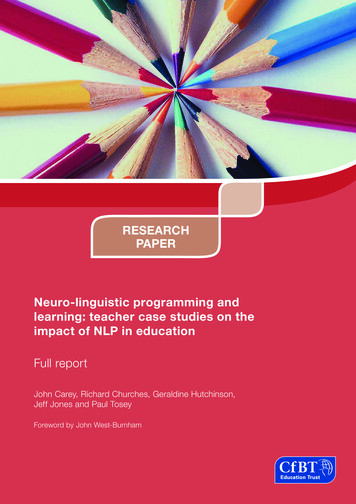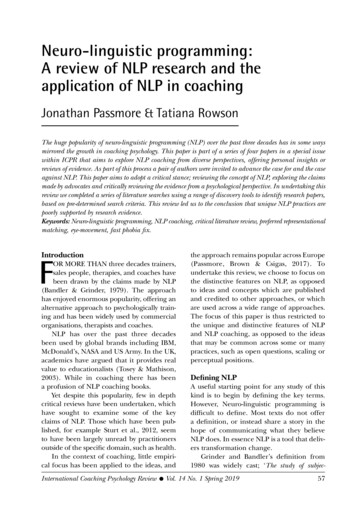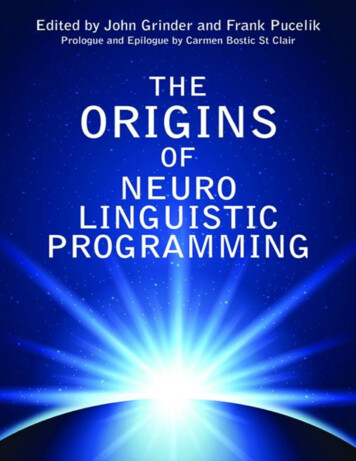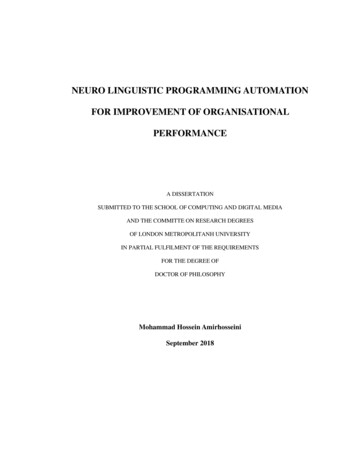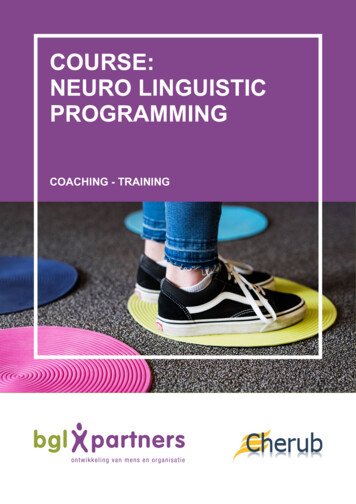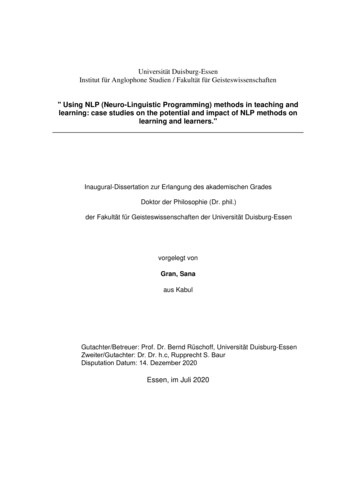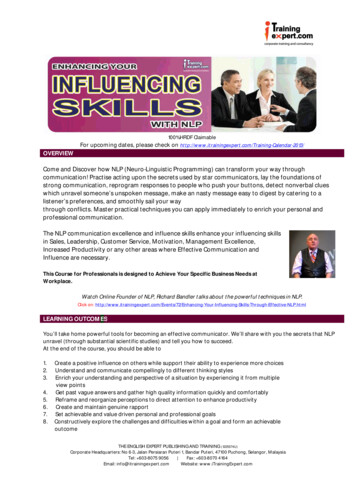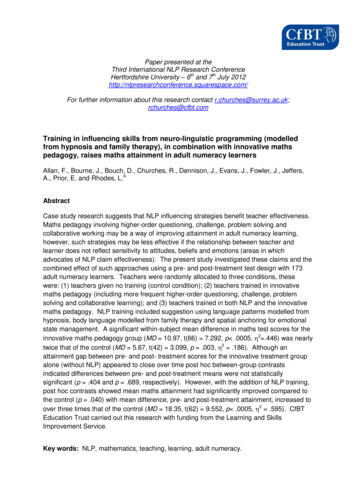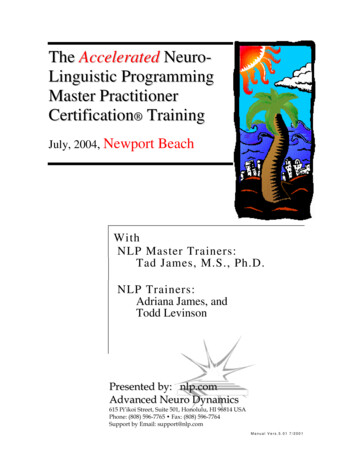
Transcription
ISSN 1798-4769Journal of Language Teaching and Research, Vol. 11, No. 3, pp. 389-398, May 2020DOI: istic Programming, Teacher’sIdentity, and Teachers’ EffectivenessYaghoob JavadiDepartment of Language Teaching and Translation, Varamin-Pishva Branch, Islamic Azad University, Varamin, IranSolmaz Azizzadeh AslDepartment of Language Teaching and Translation, Varamin-Pishva Branch, Islamic Azad University, Varamin, IranAbstract—Education especially “teaching” is considered as a valuable profession through which futuregenerations are generated and educated. In order to have a successful educational system, the maincomponents of the system must work together. It is believed that teachers are active decision-makers of anyeducational system who can bring on success to the education, accounting for about 30 percent of the varianceon pupils’ achievement. Based on different studies, developing rapport, critical thinking, self-efficacy,establishing clear goals, effective interpersonal communication, and a supportive classroom climate are someof the main determinant factors the teachers’ effectiveness. Among various variables which are related toteachers, identity is one of the important elements that affect teachers' performance. Neuro-linguisticprogramming, on the other hand, is considered as an approach which is claimed to help achieve excellence inperformance and identity. It is also considered as a supplementary technique in teaching profession whichhelps the teachers to develop outstanding skills. In this article, the researcher defines the concept of teacher’sidentity as a key element effective in the teaching profession. Then some factors that have significant impact onteachers’ effectiveness are taken into account. Also, the definition of neuro-linguistics programming, some ofits characteristics, and its implications for developing teacher’s identity and teacher’s effectiveness arediscussed.Index Terms—neuro-linguistic programming, teacher’s identity, teachers’ effectivenessI. INTRODUCTIONIn order to have a successful educational system, the main components of the educational system must work together.It is believed that teachers are active decision-makers of any educational system, and they have essential role inassigning classroom events (Hargreaves & Fullan, 1992),Consequently, teachers can bring on success andachievement to the education (Suwandee, 1995). Teachers are professional educators who have decisive roles and theirprimary responsibility is to educate, teach, train, guide, and evaluate the learners. Supriya Heyneman & Loxley carriedout a study in 1983 in 29 countries regarding the determinant factors of students’ achievement. The findings showedthat among different factors, one third is related to the teachers. Another research which was done by Sudjanaconcluded that 76.6 percent of the learning achievements of the students are affected by the performance of the teachers.According to his findings, 32.43 percent was related to the teaching ability of the teachers, 32.38 percent was related tomastery of content, and 8.60 percent was considered as the rate related to the teacher’s attitude towards the subjects.What is evident from different studies is that teachers’ performance is one of the key elements of the educationalsuccess; consequently, identifying the factors that contribute to the teachers’ effectiveness is very important. There aremany variables that are influential in this regard, including developing teacher’s identity; and improving crucial skillslike critical thinking, self-efficacy, creativity, rapport, accountability, and leadership.As McKoen and Harrison (2010) declare, identity is a “self” which is culturally and socially shaped through thecommunication with the experiences we are gained in our lives. Identity is not fixed; it is dynamic and continuallyunder construction. Identity construction is a lifelong continuum which is shaped through social interactions (Berger &Luckmann, 1991). Teacher’s identity is also the result of relationship between personal experiences of teaching,understanding of the self, and social and occupational circumstances (Kreber, 2010). Scholars increasingly focus on thebelief that teacher’s identity is an integral and fundamental element of the teaching profession (Rodgers & Scott, 2008).As Hattie (2012) suggests, teachers have the highest influence on students ‘achievement; as a result, we need toensure that this influence is optimized to have strong positive effects on our learners (Hattie, 2003). Researchers havealways tried to make a list of the features of an effective teacher, and they have conducted many researches in thisdirection. As an example, Hay McBer (2000, as cited in Anderson, 2004) has refereed to some of the characteristics ofan effective teacher. They are professionalism, critical thinking, expectations for improvement, and leadership. Burdenand Byrd (2007, as cited in Hunt, Wiseman, and Touzel, 2009) have another classification in which knowledge, skills,and dispositions are considered as the key elements of teacher’s effectiveness. 2020 ACADEMY PUBLICATION
390JOURNAL OF LANGUAGE TEACHING AND RESEARCHThere are also different studies that have concentrated on the potential effects of neuro-linguistic programming (NLP)on different aspects of educational success. Based on John Grinder and Richard Bandler (1970s), as originators ofneuro-linguistic programming, NLP is a theory of excellence identification, then modelling the identified patterns forothers to gain the same results. As a matter of fact, NLP is based on the premise that excellence is teachable andeveryone has the potential to learn it and achieve the similar results and become an outstanding performer. Pilgrims(2005), as an example, claims that NLP is an effective tool for developing rapport, setting clear educational goals,improving effectiveness and communication. Generally, NLP is a communication model, and it covers all aspects ofcommunicating. That is the thoughts, feelings, beliefs, values and identity challenges that govern the learning processitself. NLP is all about language and learning, so it is highly applicable for a language teacher. As a whole, NLP hasstarted with a strong concentration on personal and developmental growth; consequently it is applicable for variety offields like education and it leads to desirable outcomes (Bandler and Grinder, 1975).Based on the significance of teacher’s identity and effectiveness, and the implications of neuro-linguisticprogramming in the field of education and their potential impacts on teachers' trend to become more successful,professional and effective, the present study discusses each concept separately, and then takes into account theimplications of neuro-linguistic programming for teacher’s identity and teacher’s effectiveness.II. NEURO-LINGUISTIC PROGRAMMINGNeuro-Linguistic Programming (NLP) was developed by John Grinder and Richard Bandler in the early 1970s as anew method to language teaching. In that era, Grinder and Bandler studied the patterns and beliefs of people who hadexcellent behavior (Revell & Norman, 1997). These scholars believe that neurological processes (N), language (L) andbehavioral patterns learned through experience (P) are interconnected, and it is possible to change them in order toreach specific goals in life. Generally speaking, NLP is based on some predispositions about the way our mind worksand the way people act and interact. It portraits human being as a whole mind-body system and acts as an interpersonalcommunication system which studied and combines three crucial areas: Neuro, Linguistics and Programming. ‘Neuro’reflects the neurological processes (or how the body and mind interact). In other words, it relates to the way you usesenses to understand things and happenings around. Second element which is ‘Linguistics’ stands for thought patternsand the language which is used in interpersonal communication. In other words, it refers to the way you use languageand how it influences you and those around. The last part, ‘Programming’, shows the way we train the mind byanalyzing the patterns of human behavior and language use to improve attention and reach specific objectives. If we putit in another way, it reflects the way you organize ideas and actions which produce expected and unexpected results.Neuro-linguistic programming studies brilliance and quality. In other words, it studies the way outstanding people andorganizations reach to their ideal outcomes. As Siddiqui (2018) points out, adopting the techniques of NLP helps theinstructors to analyze the kind of language that used by the learners and be aware of the thought process of them. In thisway, instructors can change thoughts and actions of their learners and achieve the desirable outcomes.NLP, as its originators suggest, is ‘the psychology of excellence’ and it is based on the premise that excellence isteachable to everybody. Originators of this theory, Richard Bandler and John Grinder, assert that NLP is an art andscience of excellence. They started to work on the question that what makes some people to do the affairs in theexcellent way, whereas, others do not. Their aim was to find out what makes ‘outstanding performers’ outstanding.When people learn it, they become an outstanding performer, no matter what his past was and what his trade now is(Lady, 2007). Joanne Walter and Ardeshir Bayat call it “a process that can be applied to model excellence in any field”(Walter, Bayat, 2003). It could be a doctor speaking with her patients, a teacher interacting with her students, a judgehaving communication with lawyers, a policeman working on a file and talking with a suspect, an army officercommanding his soldiers, a business executive, a coach trying to guide the players, and so many other examples. NLP isa tool that can help all of them to reach their desired goals by creating an effective communication. The list is very longand encompasses everybody who tries to engage the phenomenon of communication. As a matter of fact, discoveringthe mystery of excellence was the main driver of the NLP pioneers to conduct related studies. The proponents of NLPdo believe that excellence is not a natural talent. Instead, they assume natural talent “a label than an explanation”(Walter and Bayat, 2003). They claim that excellence is not something rare and anybody can be loaded with thisimportant property. To this end, what is required is that we become free from any limitations that we pose to ourselvesand consider more choices.NLP is also regarded as a supplementary tool in the field of second language instruction which helps learners toachieve excellence in their performances. It is developed from the combination of “neuro”, “linguistic” and“programming” which refers to the connection of nerve network of body, their connection and reflection in languageuse, and finally the way this connection affects behavior. When we understand the process of HOW, we do somethingand we can REPEAT the same process to achieve the same result or we can CHANGE the process (or even just changea part of the process) to achieve a different result. While changing the process is known as behavioral change, repeatingthe process of how someone does something is known as modeling. The idea of modeling is applied for achieving thesame result and become successful in life (If one can achieve a goal, so all others can use the same strategy and achievethe same). This rule is applicable even to educational fields. 2020 ACADEMY PUBLICATION
JOURNAL OF LANGUAGE TEACHING AND RESEARCH391NLP can also be considered with strategic perspectives. In the UK, there are some courses that are conducted for ESLteachers (teachers who teach English as a second language) who want to use NLP in their profession. Topics of thiscourses encompasses effective communication, rapport building, recognizing different learning styles and working withthem, information gathering, improving effectiveness, and setting goals (Pilgrims, 2005) cited by Winch (2005). It isbelieved that NLP encourages language teachers to deliver the teaching programs more effectively and even apply moreteaching styles in their professions (Tompkins and Baker, 2005) cited by Winch (2005). Revell and Norman (1997)point to 13 presuppositions that are helpful for the application of NLP in the field of language teaching and learning andother fields. The whole idea is that these principles should be a part of the teachers’ belief system and shape the wayinstruction is done, no matter which teaching method is used by the teacher:1. Mind and body are interconnected: Both of them are components of the same system, and each of them affects theother one.2. The map is not the territory: All of us have special maps of the world which are different from each other.3. There is no failure, only feedback: Failure is nonsense, and there is always a second chance to be successful.4. The map becomes the territory: When you believe in something to be true, it is either true or becomes true.5. When you know what exactly you want, it helps you get it.6. The resources which are required to achieve our goals are all within us.7. Communication is verbal and also nonverbal.8. The nonconscious mind is kind.9. Communication is conscious and also nonconscious.10. There is a positive intention behind each behavior.11. The response I get is the meaning of my communication.12. To reach excellence, the excellent behavior should be modelled.13. In any system, the element which has the highest flexibility will be more influential and has the greatest influenceon the whole system.Neuro-linguistic programming has four pillars which are very effective for improving the behavior andcommunication skill of the learner. As a matter of fact, NLP was initially developed by Bandler and Grinder in order toimprove the communication skill. There are some strategies and techniques in this regard which empowers teachers andstudents to have more effective goal-oriented communications. As Siddiqui (2018) asserts, neuro-linguisticprogramming is based on neurology and communication. It is also based on the premise that each learner has a specificperceptual preferences and styles of learning. Accordingly, teachers can apply NLP strategies to develop thesepreferences and styles to provide optimum learning solutions. Additionally, there are some key concepts in NLP,including rapport building, modelling, mirroring, and anchoring. Anchoring in neuro-linguistic programming meansusing “triggers” or “anchors” in order to provide the learners with a positive mental image. When positive images arecreated, learners become motivated and gain positive attitude towards learning. Consequently, mental images help thelearners to gain positive emotions by some body movements and gestures or specific expressions. These anchors enablethe learners to become confident in the learning process. As Siddiqui (2018) asserts, mirroring is the other key conceptwhich is taken into account in neuro-linguistic programming. Mirroring is a technique used in NLP to improvecommunication. NLP mirrors the learners’ gestures, expressions, patterns of breathing, weight fluctuations, and alike tocreate rapport. It is believed that these patterns should be used in the classroom setting to improve verbal and nonverbal communication. Modelling and mirroring the patterns of the individuals who have a desirable academicperformance will help the other learners to have the similar performance in the exams and achieve the similar results.III. PILLARS OF NEURO-LINGUISTIC PROGRAMMINGNLP has got four pillars (O’Connor and McDermott 1996; Revell and Norman 1997). These four key principles are:1. Rapport: The Oxford dictionary defines rapport as “a close and harmonious relationship in which the people orgroups concerned understand each other’s feelings or ideas and communicate well.” As Delbio and Ilankumaran (2018)point out, the key pillars of neuro-linguistic programming are creating effective communication and relationship withothers and it is believed that rapport is essential for effective communication, as it maximizes the similarities andminimizes the differences between individuals. Rapport is an unconscious empathy which is shaped betweenindividuals. As asserted by Silva (2017), rapport or empathy is created by the strategies of neuro-linguisticprogramming in order to make a closer relationship between teacher and student, and therefore, in order to provide amore supportive and productive learning environment which leads to higher productivity and success. As a matter offact, we are not alone and we live in societies in which there are also other people, therefore, we must gain the ability togenerate rapport and create effective communication. In other words, shaping such skill is a ‘must’. Rapport meanshaving communication and relationship with the quality of mutual trust and responsiveness. The first pillar of neurolinguistic programming is rapport which should be built within an individual and then with others. If we put it inanother way, as a principle, it is asserted as “establish rapport with yourself and then with others.”2. Outcome thinking: This pillar relates to the goals and ends. It means that we should set our goals and know whatwe want. It is believe that the key to success is precision. The more precise you know what you want and the reason youwant it, the more likely you will reach exactly to what you desired. In another words, based on NLP, knowing precisely 2020 ACADEMY PUBLICATION
392JOURNAL OF LANGUAGE TEACHING AND RESEARCHwhat you want helps you achieve it. If we put it in another way as a principle, it can be asserted as “know what youwant.” There are five steps in this regards: Appreciate your goal, consider it as an attractive one, and make it as compelling as possible. Concentrate on your goal all day long, and set your brain on a path which ends to your objective. In this way,you will get through it much easier. Imagine that you have already achieved your goal. You should visualize the image completely, and after thatyou should walk back and try out the pathway which ends to your goal. Notice all the steps throughout this pathway. You should pay attention to all steps on the pathway towards thegoal, such as all the resources, actions, and all the people that step-by-step help you to get to the goal. Step back to the present with a new perspective on the steps and take action to reach the goal.Generally speaking, NLP is an outcome orientated discipline. That means whatever we do we must have a clearobjective or goal. In order to achieve a successful outcome one must first define the outcome and be clear on what it is.Outcome orientation is also about setting direction. A positive direction rather than a negative one. NLP acknowledgesthat negatively stated outcomes are ill-formed and more likely to get you more of the thing you don’t want. For example,it is harder to give up smoking when your intention is to “Not smoke cigarettes.” This outcome focuses you on smokingcigarettes so the chances are you will smoke more. It is a much better outcome to aim for good health, or to save moremoney and to give up cigarettes.3. Sensory awareness: It refers to using senses in order to experience the world. In other words, it means that we useour senses to look, listen to, and feel what is happening to us. Based on NLP, when we use our senses we get therequired feedback to adjust our attempts towards reaching objectives. In this case, we should notice others’communications consciously and nonverbally.Sensory acuity or awareness means using your senses and being aware of what is going on both in yourself and theenvironment around you. It is a key to success to be aware of what is working and what is not. People often used to dothings without paying attention to what works and what does not. When people make efforts to reach their goals, theymust also develop a level of awareness that enables them to distinguish between what is working (which helps them toreach the desired outcome) and what is not.4. Behavioral flexibility: It means to be adoptable in the entire situation. It means that we must should have variouschoices of action. The more choices we have, the more chances of success. If we don’t change the way things are done,we won’t get to different outcomes and what we get will be the same as before. According to this pillar of NLP, wemust change the way we do things until we get what we want. If we put it in another way, we should say that whensomething we do is not working, then we must change our behavior to get a different result. Therefore, we must havedifferent skills to act in a different way when it is necessary. This can be asserted in another way, as “keep changingwhat you do until you get what you want.” There is a rule in the science of Cybernetics that says that “in any system,the part with the greatest range of freedom will be the one controlling the system.” Consequently, when we see thatcurrent behavior doesn’t work well, we should have the required flexibility and various skills to act in another way andchange the result. As a matter of fact, neuro-linguistic programming encourages people to be flexible or adoptable indifferent situations. It also focuses that people should be flexible and accept the changes in their lives.As NLP is a communication model, it covers all aspects of communicating. That is the thoughts, feelings, beliefs,values and identity challenges that govern the learning process itself. NLP is all about language and learning, so it ishighly applicable for a language teacher. One of the important aspects related to the teachers and their effectiveness isteacher’s identity which will be discussed in the next section.IV. TEACHER’S IDENTITYIdentity has always been a critical concept in the social and cultural fields. Danielewicz (2001) describes identity as away we understand that who we are and who other people are. Accordingly, it is also the way other people visualizethemselves and others (including us). Identity is changeable and it is not a fixed concept; it is changeable andsuccessively under construction. Danielewicz (2001) puts it in this way that “Every person is composed of multiple,often conflicting, identities, which exist in volatile states of construction or reconstruction, reformation or erosion,addition or expansion” (p. 10).The present article has taken into account the type of identity which is related to the teachers in the educationalcontext. Scholars claim that one of the key elements in the teaching profession is teacher’s identity (Rodgers & Scott,2008). Identity construction is a continuous process which encompasses interpretation and reinterpretation of teacher’sself-perception; it includes the person’s understanding about who she or he is and will become (Beijaard et al., 2004).Danielewicz (2001) writes, “I regard ‘becoming a teacher’ as an identity forming process whereby individuals definethemselves and are viewed by others as teachers” (p. 4). Varghese et al. (2005), especially in the field of languageteaching, assert that “In order to understand language teaching and learning we need to understand teachers: theprofessional, cultural, political and individual identities which they claim or which are assigned to them” (p. 22).Actually, processes of identity formation are related to the discourses and the communities that we live and work within.To gain knowledge about how to become an effective teacher needs passing through a long and complex way.Different theoretical approaches to teacher’s identity do exist; some concentrate on its social and cultural nature, while 2020 ACADEMY PUBLICATION
JOURNAL OF LANGUAGE TEACHING AND RESEARCH393others concentrate on its discursive and narrative nature. However, many of these day’s approaches assert that identityis socially embedded phenomenon, and this concept is ever-changing and dynamic (Rodgers & Scott, 2008). Teacher’sidentity is not constructed in a vacuum, and it is developed in a social and cultural context (Holland & Lachicotte, 2007;Penuel & Wertsch, 1995). As different studies point out, one of the influential strategies for teacher’s identitydevelopment is neuro-linguistic programming. Whereas effective communication is one of the key components of NLP,establishing a positive relationship is fundamental for teacher’s identity development. As it was mentioned in theprevious section, rapport is one of the main pillars of NLP. Consequently, it can be used as a tool for teachers. Ifeducation is essential to a high-quality future, the key is in the hands of the teachers. Providing learners with excellentskills needs effective teachers, and employing the tools of neuro-linguistic programming may help teachers to beeffective in the teaching profession and become successful.V. NEURO-LINGUISTIC PROGRAMMING AND TEACHER’S IDENTITYIn recent years, different researches has been allocated to investigating the teachers and their growth, professionalidentity, teachers’ notions and perspectives, teachers’ narratives, and biographies (Rodgers & Scott, 2008). Researchfindings show that teacher’s identity is highly connected with various concepts including self-confidence, inspiration,flexibility, self-efficacy, and commitment (Danielewicz, 2001). Different studies have concentrated on the importanceof teachers’ identity and its effect on the teachers’ professional development (Eick & Reed, 2002) and many researcheshave concluded that NLP is regarded is an effective tool for personal and educational development (e.g. Tosey, 2010and Tarnopolsky, 2016).Since teachers educate and generate the future generations, teaching is highly regarded as a valuable profession. Inorder to have a successful educational system, the main components of the educational system must work together. It isbelieved that teachers are active decision-makers of any educational system, and they have essential role in assigningclassroom events (Hargreaves & Fullan, 1992), and can bring on success and achievement to the education (Suwandee,1995). Generally, identity has been defined as a “self” which is shaped in society and in relation to the culture, throughlife’s experiences and the communications about these experiences (McKeon and Harrison 2010). Identity is a lifelonglearning process which is developed via social relations and processes (Berger and Luckmann 1991). Correspondingly,identity is shaped through the interplay between personal theories of teaching, notions about self and social andoccupational contexts (Kreber 2010). So, one of the important factors is communication and as it was suggested it is oneof the influential factors that affect identity. As Tarnopolsky (2016) also claims, communication is one of the mostcrucial elements for teachers and teaching profession as a whole, especially the communication between teachers andlearners. Mutual communication between teacher and students in the classroom and also between each individualstudent may be considered as an important factor. Consequently, to create a good relationship, there should be aharmony between the teacher's manner of teaching and student's needs, wants, and wishes (either conscious orsubconscious). To create such harmonization, nothing is helpful but establishing the optimum rapport between theteacher and every individual student in the classroom. Accordingly, there should be some algorithms, and some patternsof behavior and reaction for the teachers to facilitate rapport building. As Tarnopolsky (2016) claims, NLP providesthese algorithms and patterns and can be beneficial in this regard. As it is shown by different findings, NLP is one of themost useful instruments that can be used for establishing rapport in classroom relationships and interactions, especiallythose in the EFL/ESL classroom. Teachers should advise students about notions, ideas, and ways of doing things andalso the necessity and importance of doing them. In this way, the teacher has the opportunity to lead students in therequired direction. But, one important point is that although teachers should advise students and instill the ideas andnotions, these ideas should not be imposed or forced to them. This point is one of the main aspects of rapport buildingin NLP. In this manner, the feeling of manipulation is not created by the students and the feeling of being facilitatedbegins to shape. This feeling is the result of either acceptance of what is suggested by the teacher or is because studentshave become convinced that the proposed course of action is the best for them.As Tolsey (2010) asserts, one of the issues which is concentrated in NLP courses is the potential for selfdetermination. Bandler and Grinder (1975), as the originators of NLP, emphasize that self-determination is quitepossible by overcoming learnt self-limitation and finally leads to personal development. There is another importantelement that should be taken into account. It is teacher's self-control, which means that teacher is capable of controllinghis or her feelings, moods, attitudes and their manifestations in behavior. The teacher is a human being who like anyother person has his own problems, undesirable moments, anger, fatigue or frustration, and such unwanted feelings.Experienced teachers are capable of controlling these sensations in a way that their feelings don’t affect others anddon’t influence the teaching quality. They also try to control themselves to save the rapport which is built betweenthemselves and the students. But, the situation may be problematic for young teachers who don’t have the sufficientexperience for controlling their feelings. These beginners need more time to deal with NLP strategies to overcome theproblem. They need sympathy and also empathy with learners; th
neuro-linguistic programming, NLP is a theory of excellence identification, then modelling the identified patterns for others to gain the same results. As a matter of fact, NLP is based on the premise that excellence is teachable and everyone has the potential to learn it and achieve the simi
